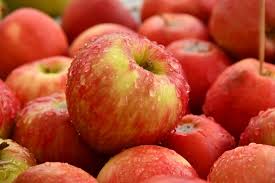
Scientific Name:Malus domestica
LifeTime:1 to 2 Months
Kingdom:Plantae
Clade:Tracheophytes
Order:Rosales
Family:Rosaceae
Genus:Malus
An apple is an edible fruit produced by an apple tree (Malus domestica). Apple trees are cultivated worldwide and are the most widely grown species in the genus Malus. The tree originated in Central Asia, where its wild ancestor, Malus sieversii, is still found today. Apples have been grown for thousands of years in Asia and Europe and were brought to North America by European colonists. Apples have religious and mythological significance in many cultures, including Norse, Greek and European Christian tradition. Apple trees are large if grown from seed. Generally, apple cultivars are propagated by grafting onto rootstocks, which control the size of the resulting tree. There are more than 7,500 known cultivars of apples, resulting in a range of desired characteristics. Different cultivars are bred for various tastes and use, including cooking, eating raw and cider production. Trees and fruit are prone to a number of fungal, bacterial and pest problems, which can be controlled by a number of organic and non-organic means. In 2010, the fruit's genome was sequenced as part of research on disease control and selective breeding in apple production.
In Norse mythology, the goddess Iðunn is portrayed in the Prose Edda (written in the 13th century by Snorri Sturluson) as providing apples to the gods that give them eternal youthfulness. English scholar H. R. Ellis Davidson links apples to religious practices in Germanic paganism, from which Norse paganism developed. She points out that buckets of apples were found in the Oseberg ship burial site in Norway, that fruit and nuts (Iðunn having been described as being transformed into a nut in Skáldskaparmál) have been found in the early graves of the Germanic peoples in England and elsewhere on the continent of Europe, which may have had a symbolic meaning, and that nuts are still a recognized symbol of fertility in southwest England.[28] Davidson notes a connection between apples and the Vanir, a tribe of gods associated with fertility in Norse mythology, citing an instance of eleven "golden apples" being given to woo the beautiful Gerðr by Skírnir, who was acting as messenger for the major Vanir god Freyr in stanzas 19 and 20 of Skírnismál. Davidson also notes a further connection between fertility and apples in Norse mythology in chapter 2 of the Völsunga saga when the major goddess Frigg sends King Rerir an apple after he prays to Odin for a child, Frigg's messenger (in the guise of a crow) drops the apple in his lap as he sits atop a mound.[29] Rerir's wife's consumption of the apple results in a six-year pregnancy and the Caesarean section birth of their son—the hero Völsung.[30] Further, Davidson points out the "strange" phrase "Apples of Hel" used in an 11th-century poem by the skald Thorbiorn Brúnarson. She states this may imply that the apple was thought of by Brúnarson as the food of the dead. Further, Davidson notes that the potentially Germanic goddess Nehalennia is sometimes depicted with apples and that parallels exist in early Irish stories. Davidson asserts that while cultivation of the apple in Northern Europe extends back to at least the time of the Roman Empire and came to Europe from the Near East, the native varieties of apple trees growing in Northern Europe are small and bitter. Davidson concludes that in the figure of Iðunn "we must have a dim reflection of an old symbol: that of the guardian goddess of the life-giving fruit of the other world."
Apples appear in many religious traditions, often as a mystical or forbidden fruit. One of the problems identifying apples in religion, mythology and folktales is that the word "apple" was used as a generic term for all (foreign) fruit, other than berries, including nuts, as late as the 17th century.[31] For instance, in Greek mythology, the Greek hero Heracles, as a part of his Twelve Labours, was required to travel to the Garden of the Hesperides and pick the golden apples off the Tree of Life growing at its center.[32][33][34] The Greek goddess of discord, Eris, became disgruntled after she was excluded from the wedding of Peleus and Thetis.[35] In retaliation, she tossed a golden apple inscribed Καλλίστη (Kalliste, sometimes transliterated Kallisti, "For the most beautiful one"), into the wedding party. Three goddesses claimed the apple: Hera, Athena, and Aphrodite. Paris of Troy was appointed to select the recipient. After being bribed by both Hera and Athena, Aphrodite tempted him with the most beautiful woman in the world, Helen of Sparta. He awarded the apple to Aphrodite, thus indirectly causing the Trojan War.[36] The apple was thus considered, in ancient Greece, sacred to Aphrodite. To throw an apple at someone was to symbolically declare one's love; and similarly, to catch it was to symbolically show one's acceptance of that love. An epigram claiming authorship by Plato states